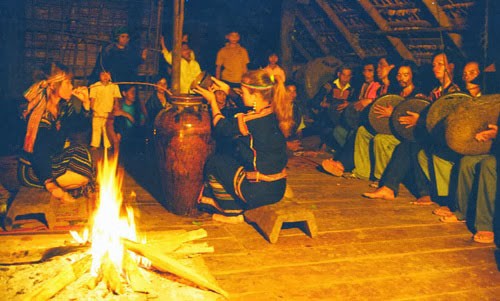(VOVworld) – The kitchen plays an important role for every ethnic family in Vietnam. The cooking place is also a venue where rituals and other customs occur. Whenever a guest arrives, the host makes a fire to show hospitality.
 |
A fireplace of the Ede (Photo: netnews.vn)
|
Ethnic minority people believe everything has a soul and a fire genie. A cooking fire can be made a various spots, but must follow strict rules. For Mong people, a fire is the incarnation of revival and family protection. Vi Van An, a folklorist with the Vietnam Museum of Ethnology, said: “A Mong family considers their cooking fire very important. After building a house, they invite experienced builders to make a fireplace. When the fireplace is ready, a pan is placed on it. The Mong rarely lend out their pans. If they do, they put a stone on the fireplace to replace the pan”.
Each Mong family has 2 fire areas: one small, one big. The big one is in the main room and is used for heating and cooking. This is considered the most sacred space, where the ancestors are worshiped. Guests must get the permission of the hosts to enter this area. The smaller fire area, which is located at the back of the middle room, contains two fires: one for cooking mèn mén (steamed-corn powder, the staple food of the Mong. The other is used to cook food for the pigs and make wine. There are certain taboos: people are forbidden to step on the cooker or knock on cooker with a stick because these acts are believed to harm the family’s animal husbandry.
The Khmu people in Nghe An province consider their cooking fire an embodiment of the fire genie and of life. Whether their house is big or small, each house must have 3 kitchens. The first kitchen in the first room of the house is for cooking daily meals and receiving guests. The second kitchen, in the middle room near the middle pillar, serves as a place of worship. The third kitchen, in the last room, is used to cook sticky rice. So, the second kitchen is the most important area, where the family members celebrate major events of the year. Folklorist Vi Van An said:
“The Khmu are unique in reserving a special kitchen for worshiping the ancestors, who are considered a supreme force. When people slaughter a buffalo or a cow to offer to their ancestors, only this kitchen is used.”
Fire and kitchen play a key role in the spiritual life of ethnic groups in the Central Highlands. The fire genie is present at all family festivals like longevity congratulation ceremonies and New Year and new rice celebrations. Villagers dance around a bonfire to the accompaniment of gongs.
The Ha Nhi, who inhabit Vietnam’s northern mountains, still worship the Kitchen God. In addition to putting a fire in the main room, people place a mysterious stone, an incarnation of the Kitchen God, who protects the family from evil forces. The kitchen is not only a cooking place, but also a place where women take care of their families by, for example, boiling the water every morning. During New Year festivals, the act of making a fire expresses the villagers’ gratitude to their ancestors.